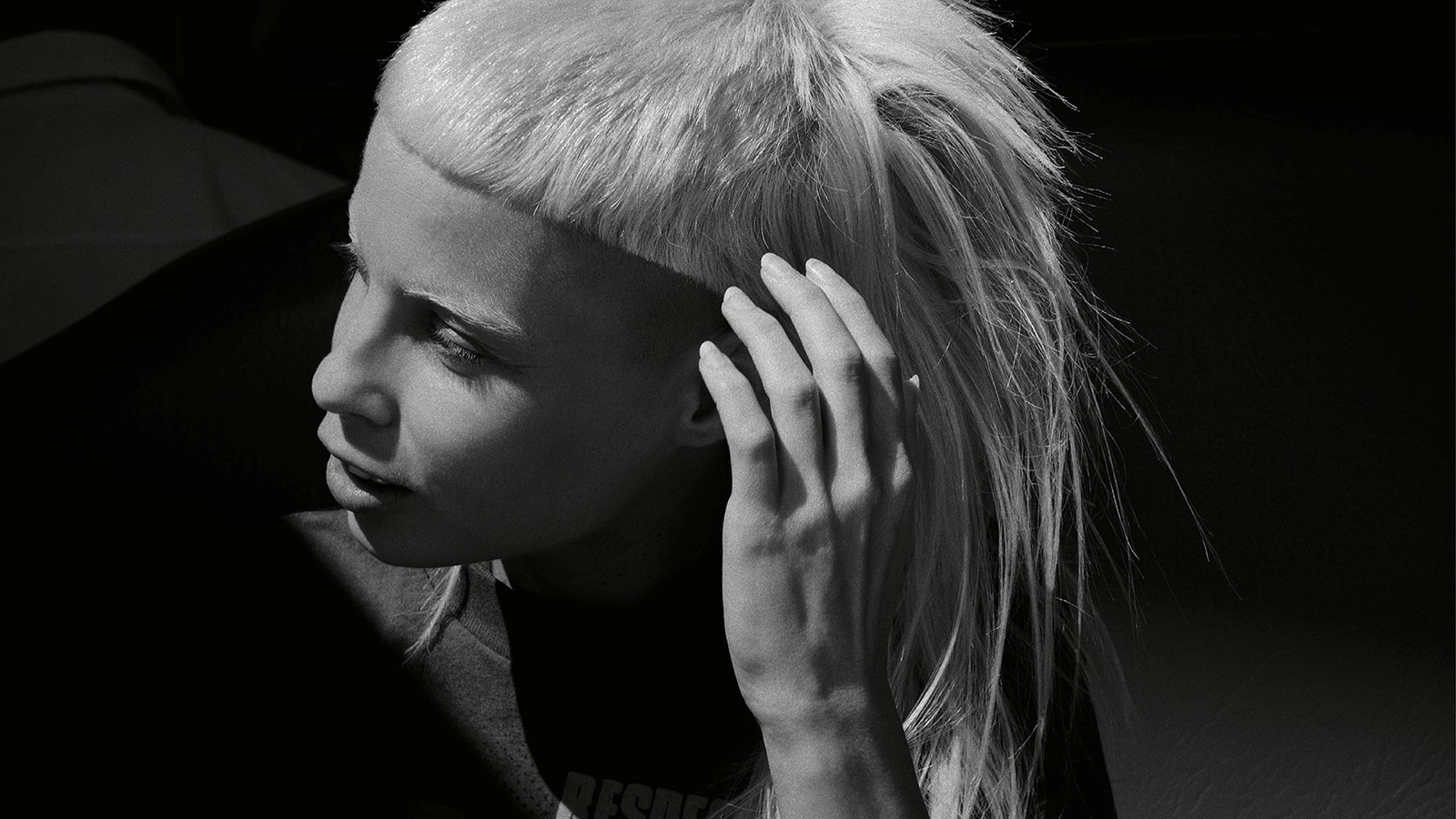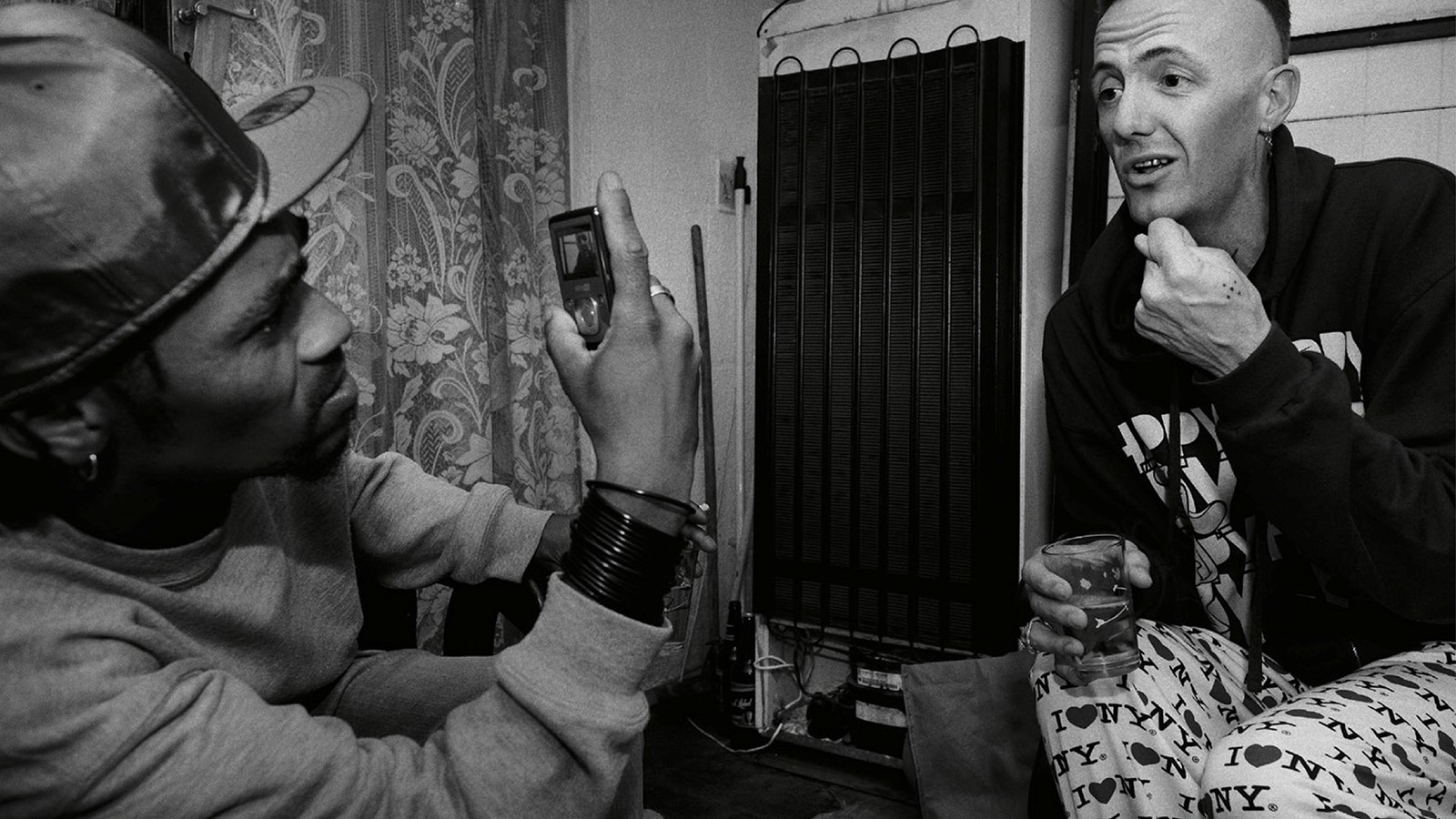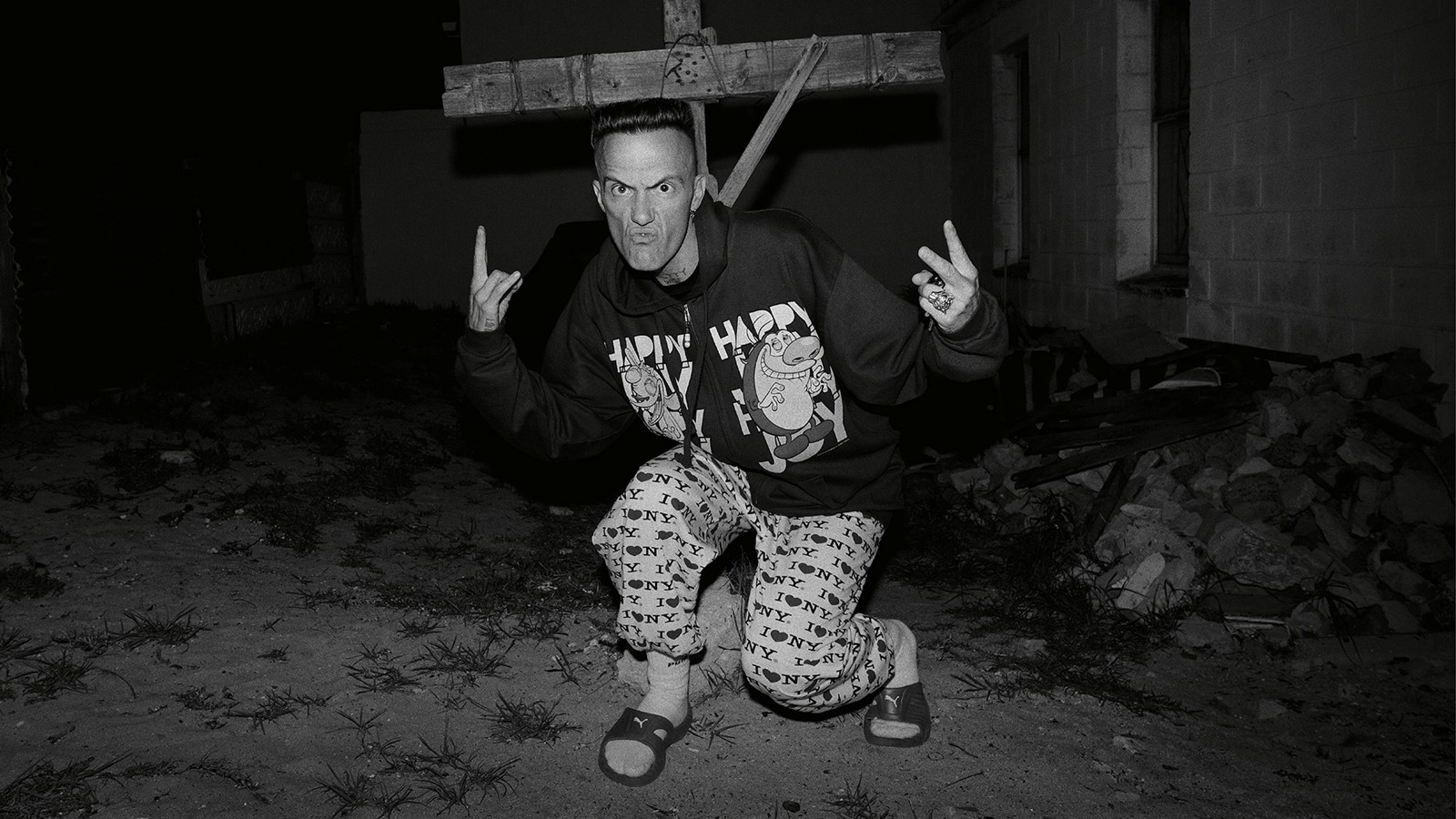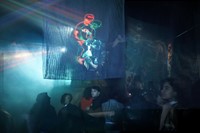Take a trip to the zef side of Cape Town to meet the interweb phenomenon whose countercultural energy is still capturing our attention
Taken from the June 2010 issue of Dazed:
Today, their 56th day since becoming celebrities, Die Antwoord rappers Ninja and Yo-Landi Vi$$er have come to Golden Acre, a run down shopping centre in Cape Town, to talk about world domination over a Wimpy milkshake.
Since BoingBoing.net blogged about them on 3 February 2010, the rap rave crew’s “Enter the Ninja” and “Zef Side” music videos have racked up over five million views on YouTube and sparked off a debate about authenticity, class and race. Hipster girls across the world have been heard asking their hairdressers for “the Yo-Landi”, and the biggest players in the recording industry flew them over to LA and New York, desperate to find out the secret of their success. Somewhere along the line, they even squeezed in a coffee with David Lynch and inked a deal with District 9’s director Neill Blomkamp to shoot their next promo.
Sliding into the booth, Ninja, a lanky man with the kind of flat-top that hasn’t been rocked by a white rapper since Vanilla Ice’s heyday, flashes a smile punctuated by gold caps. “It’s like an acid trip that just won’t end,” he says soon after arriving wearing a, er, Vanilla Ice t-shirt and the infamous Dark Side of the Moon boxer shorts he sexually assaulted in the “Zef Side” clip. Yo-Landi, his petite partner in rhyme, an attractive peroxide blonde some YouTubers have crudely dubbed as jailbait, sits next to him and orders a bubblegum shake. Ninja goes for strawberry. Our photographer plumps for chocolate. I choose vanilla. “It’s like South Africa right here,” Ninja laughs as the shakes arrive. “The fucking rainbow nation!”
In person, Ninja’s harsh barnet, heavy brow, and “Pretty Wise” neck tattoo should be an intimidating blend. But he turns out to be surprisingly polite, as does Yo-Landi, who has one of the most mischievous Afrikaans accents you’re likely to come across. This morning there’s none of the stylised aggro wigger attitude that has propelled them from starving artists to the flag-bearers of South African pop music. If anything, they’re still coming to terms with the fact that anyone gives a shit about them. After spending more than a year trawling around the country’s darkest nightclubs, their flash fame has grown so large that a new Cape Town guidebook namechecks them alongside Table Mountain and Nelson Mandela. They laugh when hearing this.
“That’s crazy! That’s fucking weird,” says Ninja, genuinely taken aback. “I mean we’ve only been famous for a few weeks! They can make statues of us next to Mandela. Tourists can go and take photos of us with pigeon cack on our heads.”
Unsurprisingly, the guidebook’s author decided not to run an excerpt of Ninja’s infamous “Whatever Man” monologue from the “Enter the Ninja” video, in which he sneers, “I represent South African culture. In this place you get a lot of different things, Blacks, Whites, Coloureds, English, Afrikaans, Xhosa, Zulu, watookal. I’m like all these different things, all these different people, fucked into one person…” In a country still coming to terms with the apartheid era, Ninja seems unrepentant about broadcasting such a provocative socio-political statement.
“It’s just our style. People think too much,” the 35-year-old MC says between slurps of frothy pink milk. “We don’t really think that much about what we do, it’s just fun. The country’s run by black people and all kinds of different people live here – it’s like a fucked up cultural fruit salad. We’re really not a perfect rainbow nation. The racism is fucking old school, but in America it’s worse because it’s hidden, whereas here it’s out in the open. Here it was this massive philosophy, this huge wound – it was revealed and people poured medicine on it and it kind of got turned around. It’s boring to me cos everything’s fucking fine. I’m not a racist.”
“I am Afrikaans,” Yo-Landi continues, hugging her legs. “It wasn’t ever something that I thought about. Lots of people speak Afrikaans. It’s not a statement; it’s just a language that we use to communicate. It has its own flavour, it’s got its own slang. People laugh. People like it. They like us being open.”
One of the main reasons that Die Antwoord have blown up so quickly is because their videos play up to social stereotypes and walk a thin line between farce and performance art. In “Enter the Ninja” deformed progeria sufferer Leon Botha lip-syncs and pulls B-Boy poses, Yo-Landi strips out of a schoolgirl uniform and sings about being a butterfly, while Ninja raps infront of a Keith Haring-esque backdrop at a pace that would make the Blackout Crew shout for a rewind. In “Zef Side” they present a tongue-in-cheek vision of the “zef ” redneck lifestyle – a poor white township full of gap-toothed drunks, pimped out motorbikes, and, most memorably, Ninja dancing in slow-mo while Yo-Landi gazes adoringly at his man-junk flapping about in those Pink Floyd boxers. In short, most people don’t know if Die Antwoord is just one big joke.
“He wears those things like every fucking day,” Yo-Landi laughs, looking at the prog rock pants. “They scare me, those underpants. When I bought them, I had no idea that they’d become famous! He says he washes them, but I’m not sure.”
“I do wash them!” Ninja interjects. “I get scared when I think about losing them. They make me feel safe!” he chuckles before adopting a more sombre tone. “I’m serious about everything. I’m fucking serious about my hairstyle. We’re pop art fused with high art. We’re also full on into performing as a rap group and making films. We get criticism for doing that and it’s retarded. We’re fucking serious about our art and what we do, but we also have a sense of humour. I think because people can’t understand our style they think it’s a joke. Our music isn’t intellectual – we make music for the common man. What’s really the joke is the state of pop music over the last ten years. But don’t worry cos this is the future. Die Antwoord is here. I’ve drawn a line before, so let’s move forward now.”
“We’re fucking serious about our art, but we also have a sense of humour” – Ninja
Ninja has drawn lines and moved forward many times before. To many people in South Africa, his trailer trash samurai persona is simply the latest in a long line of alter egos for Watkin Tudor Jones: the frontman for groups like Evergreen, The Constructus Corporaton, and, along with Yo-Landi, Max Normal. As MC Totally Rad, who Dazed featured in our 2004 South Africa special, he released a less polished version of “Beat Boy”, the Bronski Beat-inspired track that eventually found fame in the “Zef Side” clip. So why did Waddy decide to become a Ninja?
“We’ve been working for a long time, but I finally worked out my E=MC2 of entertainment. That’s why we called it The Answer (English translation of Die Antwoord), because it was either going to save our asses or we would be fucked. It’s on that level for me. The other stuff was more experimental and this is more of a signature. I wasn’t unhappy... I wanted to dispose of everything, because everything else that we did was disposable. Plus ninjas are just fucking cool.”

There is another side to Ninja that has much more serious connotations than merely changing his rap name or the height of his flat-top – inked onto his torso are contradicting gang tattoos from each of Cape Town’s “numbers” gangs: the 26s, 27s and 28s. He has one of Richie Rich, which symbolises the 26s – the money lovers. On his chest he has the 27s tattoo of a ghostly hand gripping a knife, which symbolise the murderers – they keep the peace between the 26s and the 28s. And on his arm is a tattoo of Casper the Friendly Ghost with a massive erection, which represents the 28s – a prison rape gang that has “legalised” homosexual prison sex. Tattoos are the outward symbols of rank, status and gang affiliations, yet Ninja has never belonged to any of the numbers. Isn’t he scared that it’s a step too far?
“It’s like a peace gesture,” he smiles, gold glinting in the sun. “I didn’t even know that the Richie Rich one was a gang sign. A lot of people have said that I’m not allowed it, but I just saw it on the back of a taxi! I’m sorry! I won’t do it again! I don’t know… we’re all in the same gang, we’re not scared of anything. I mustn’t be scared. People don’t understand white people saying those things.”
After the milkshakes we drive over to Woodstock to their friend Dragon’s house to take some photos. (I say house, but crack shack is probably more accurate.) DJ Hi-Tek, the chubby bassline genius behind the zef rap rave sound is still nowhere to be seen. Ninja informs me that the bedroom producer “is fuckin’ anti-social and doesn’t tour with us either”, so we leave it at that. Yo-Landi sits on a tatty sofa and plays with her pet rats, Ying and Yang.
Dragon, a huge ripped black guy from the Congo, stands in the corner of the crumbling den smoking some seriously stanky weed and shouting “Ninja! Louis Vuitton!” every few minutes. Legend has it that Dragon once woke up in the middle of the night with a knife at his throat and five men pointing guns at his head. He killed them all with his bare hands. Luckily he’s less hectic when stoned, but is a bit pissed off that Die Antwoord didn’t bring him back any LVMH from the States. Or a work visa. He mumbles something about “making people disappear” and then goes into the next room. “Orinoco Ninja Flow” – a Die Antwoord remix of Enya – pumps out of a laptop. Ninja rubs his shirt into the dirty floor.

After shouting the “sail away mothafokkaz!” chorus, Yo-Landi slips into a pair of short shorts and half-cut top that shows off a page three frame. Earlier the pair admitted that they once “accidentally had a kid”, but weren’t together any more. “We’re just friends and we make music. We’re down with each other, but everything’s behind us and this is at the front.” Watching their playful interaction as the flashgun goes off, I’m not sure if I entirely believe the platonic assertions, but it’s not really any of my business, so I show Dragon some video footage of him blowing ganja smoke into a shaft of sunlight. He approves. Thank God.
Before the shoot wraps, Die Antwoord ask if I want to meet their friend Isaac Mutant, the pioneer of Afrikaans rap. He lives over in Mitchell’s Plain, one of the most hardcore townships in Cape Town. They need to drop off some swag from their recent American trip.
“Have you ever had 5,000 new emails in your inbox? It’s fucking insane. Now I don’t sleep at night. I just lie there and look at the roof” – Ninja
Three hours later, we’re hurtling towards the Cape Flats with six pizzas and a couple of cases of beer in the boot. There’s a full moon and in the distance people are climbing Lion’s Head mountain by torchlight. “There was a full moon on the third of February,” Ninja says, recalling the night their website servers crashed and their lives changed forever. “After looking at the interweb I looked up at it. Have you ever had 5,000 new emails in your inbox? It’s fucking insane. It means you don’t look at your email anymore. It’s like a wall of sound. Now I don’t sleep at night. I just lie there and look at the roof. And then I get up and walk fucking far.”
“I saw him one morning and I asked what he had been doing,” Yo-Landi chuckles. “He just said ‘I’m walking.’ I was like, ‘You look mental.’ It was eight in the morning and he had this really mental look in his eyes.”
As the small hatchback speeds down the quiet N2 motorway, the hyper duo talk excitedly about their love of William Gibson’s Neuromancer, Yo-Landi’s age (“It’s confidential”), being photographed by Roger Ballen for the cover of their debut album $O$, and how they think their music is perceived across South Africa.
“In some magazines we’re billed as a national embarrassment because we’re the biggest South African group ever to make it overseas,” Ninja says. “People are like, ‘Die Antwoord are fucking up the country’s image.’ People hate us, like death-threat hate.”
“It’s because we swear so much in Afrikaans,” Yo-Landi continues, talking about their song “Jou Ma Se Poes in ‘n Fishpaste Jar” (“Your Mother’s Cunt in a Fishpaste Jar”). “We say the worst Afrikaans swear words you can possibly think of. We sing them repetitively in our lyrics and to them it’s too much.”
“But young kids,” Ninja says wide-eyed, turning away from the road, “They loooove us. It’s only the old white Afrikaans people who don’t.”
Outside, there are hardly any cars left on the motorway. Yo-Landi cracks open a bottle of cider and gazes out at the low-level township houses covering both sides of the road.

“We’re heading into the dark side now. Don’t worry,” says Ninja as he points out the Mitchell’s Plain sign. “It’s better to come here at night, because it’s dark. A lot of hijackings happen here during the day. If you look in the other cars there are no whities. But I’m not going to put up my hood because it would ruin my perfect hairstyle. That’s why most people in the Cape Flats have tinted windows so you can’t see who’s in the cars. It’s a safety thing and also a gangsta thing. Yo-Landi failed her driving test because her windows were too black.”
Ninja parks in a quiet close in the Rocklands township and we walk into a one-storey concrete flat – Isaac Mutant’s house. Inside, Isaac and a few members of his KAK crew (Koloured As Krooks) are watching a football match while his small daughter runs around shouting. His wife Kim, her sister and her mother greet the homecoming heroes. After various neon baseball caps and shirts have been shared out, Isaac kicks a few freestyles with a swagger that puts most American rappers to shame. Ninja laps it up, acting as a hype man. The old friends then talk about starting a group called Teenage Mutant Ninja Turtles to teach teenagers how to rap. As they discuss the gangsta lexicon that powers Afrikaans slang, a ten-strong gang walks past the house and peer through the open door at the scene. They look confused, wondering what a group of white people wielding fluro t-shirts and video cameras are doing in their hood. I ask Isaac what he thinks of Ninja’s gang tattoos.
“They’re dangerous. I don’t know anybody who would have those tats. You need balls to have them. That’s like a sneak preview into this cat’s character. In the Cape Flats it’s seen as an honour to have tats like that. They could save your life, but they could also get you killed. The first time my brother saw his tats he didn’t know what to think. You definitely have to have balls to have them. I guess sometimes when you’re young, you think you’re immortal.”
Ninja changes the subject by giving Isaac a camera to film him rapping a new acapella about a groupie called Miranda. He has the whole place in stitches. Yo-Landi and the girls giggle in the kitchen about a friend called Garlic who nearly died from swallowing his false teeth. It’s a lekker vibe, with everyone hyped up by tales of Die Antwoord’s recent transatlantic adventures with Jimmy Iovine and David Lynch.
Finishing the beers and pizza, Yo-Landi and Ninja carry out one of Kim’s artworks – a porno mag montage – to the car, say goodbye and take the deserted road back to Zef town. As they drop me off, Ninja gets out and gives me a man hug. “Tell the people from the UK it was real, man. Or if not, say that we’re funky holograms designed by Neill Blomkamp.”
A fortnight later Die Antwoord fly back out to LA to appear at Coachella, and finalise a major record deal. Even though they only play for 20 minutes, their set draws over 30,000 zeflings and they’re heralded as one of the highlights of the festival, alongside Jay Z, Thom Yorke, Gorillaz and Faith No More. The next day I get an email from Ninja:
“Fuckin fuck the crowd looked like fuckin CGI ive never seen so many people looking at me like 30 000+!!!! they loved us like crazy! it was wild out of control nice!” Say what you will about Die Antwoord, they make an impact wherever they go, whether that’s making people laugh, squirm or dance. But will their polarising image, potty slang and gangland provocations come back to haunt them as South African race relations threaten to boil over following the death of Eugene Terre’Blanche? Will they end up as just another quirky footnote in YouTube history? Or will they become the biggest party rap crew in the world? Considering what they’ve achieved in the space of a few weeks, it’s impossible to predict what will happen next. Except chaos. You can count on that.





















